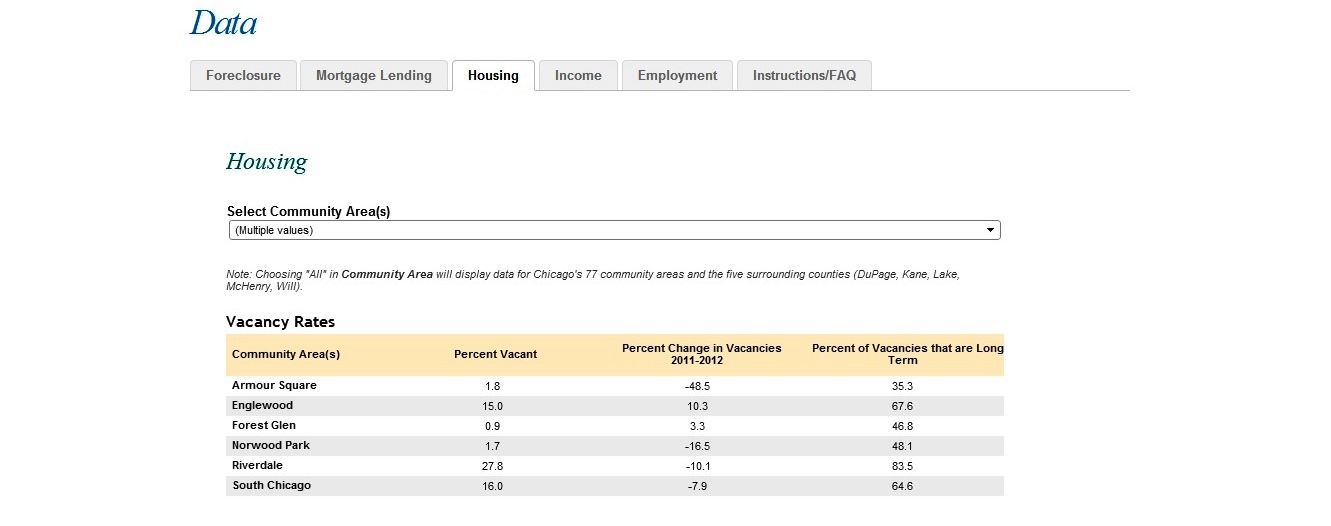
The Woodstock Institute recently launched a data portal for Chicago and the six-county region. The portal allows users to view data on foreclosures, mortgage lending, occupancy rates, income, and employment. Excited for this new tool, we wanted to try out the portal for ourselves. We decided to analyze the Chicago communities with the highest and lowest vacancy rates. The issue of vacant properties is important because vacancies have increased since the foreclosure crisis and are harmful for neighborhoods. Related problems include safety concerns, health risks, and lower property values. Further, discrimination has occurred across the country in minority neighborhoods. The National Fair Housing Alliance found that some major banks that own foreclosures do not maintain the properties in minority neighborhoods as well as they do in white communities.
Observing 2012 vacancy rates in Chicago, the three community areas with the highest rates are: Riverdale (27.8%), South Chicago (16%), and Englewood (15%). The three community areas with the lowest rates are: Forest Glen (.9%), Norwood Park (1.7%), and Armour Square (1.8%). We used the data portal to learn about different aspects of the neighborhoods and found stark differences between the community areas on opposite sides of the vacancy rate spectrum.
Forest Glen and Norwood Park have similar demographics. Both are located on the Northwest side of the city, are majority white communities, and have a large number of homeowners. Out of the six communities examined, they have the highest average household incomes. In fact, Forest Glen has the largest number of high-income residents and the fewest low-income residents, and there is a $36,000 difference between Norwood Park and the third highest income in the group. Armour Square is a majority Asian community and includes Chinatown in its borders. It has a high rental rate and has the fourth highest average household income of the six communities. Forest Glen, Norwood Park, and Armour Square all have low foreclosure rates and the long-term vacancy rates are less than 50%. The high rental rate may explain the low rates in Armour Square but more information would be needed to support that theory. Many mortgage applications were accepted, showing that people are purchasing homes in these areas.
The neighborhoods of Riverdale, South Chicago, and Englewood look vastly different from the other communities. All three areas are majority black and high rental communities, and are located on the South side of the city. Riverdale and Englewood have the lowest average household incomes of the six neighborhoods analyzed, and South Chicago has the third highest average household income. Riverdale has the lowest number of high-income residents and the largest number of low-income residents. Englewood and South Chicago have relatively high foreclosure rates, which is especially interesting because they are high rental communities. The data shows, however, that many multi-family buildings have been foreclosed in the neighborhoods. In Englewood, more multi-family buildings than single-family homes went into foreclosure. The number of foreclosures in South Chicago were approximately even between multi-family and single-family buildings. Additionally, the long-term vacancy rates for all three neighborhoods are 65% or higher. Few people are buying homes in these three communities – most mortgage applications have been denied, if they were submitted at all. In Englewood and South Chicago, many mortgage applications have been denied since 2007. Beginning in 2008, few applications have been submitted in Riverdale and the majority of those submitted in 2008 were denied.
The vivid pictures described in these six neighborhood profiles reveal much about a larger story of inequality that is present in Chicago. The community areas with very high or very low vacancy rates have other defining characteristics revolved around race, income, and occupancy rates. Chicago is a large urban area and its problems are complex. Woodstock Institute’s data portal is a useful tool to identify and examine community issues. Its user-friendly portal pulls from multiple sources to help users easily work with data. The portal is a great asset for Chicago and the six-county region, and will benefit community leaders as they use the data to create positive change!
Access the Woodstock Institute’s data portal here.
By Casey Griffith, Research and Outreach Coordinator
